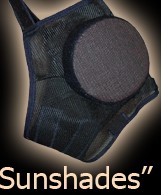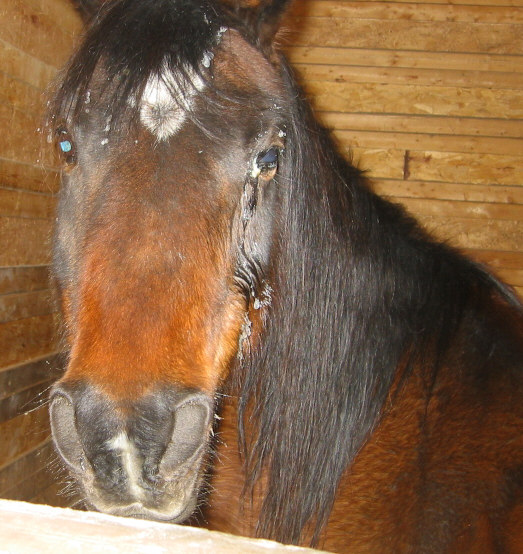Equine Uveitis
Equine Recurrent Uveitis (ERU)
or
"moon blindness" is an inflammation of the inside of the eye.
It is associated in some cases with leptospira bacteria, it also has an
immune-mediated component. Uveitis can be sub clinical where no
outward signs are seen until the horse turns up blind in one or both eyes.
Uveitis can be very painful, and can effect one or both eyes, usually in
time both eyes are affected. Uveitis isn't contagious and studies have
shown that the condition, and blindness, does seem to be more prominent
in Appaloosas, and Paints, compared to other breeds, the list of high risk
breeds however, is sadly growing over time. Changing weather
and environments are also a large factor in increasing conditions.
Treatments
ERU is usually treated
with topical corticosteroids (after your DVM has determined there are no
corneal ulcers), and topical antibiotics. Often, Banamine is
used systemically to help with the inflammation.
Aspirin therapy is used
in some cases between flare-ups to decrease the progression of the
disease. Uveitis usually does progress over time often to blindness
and even then can still flare up, and be painful for the horse. It
is recommended to have your horse tested.
Aside from aspirin
therapy, (ask your DVM and the veterinary ophthalmologist) there is
little that can be done to prevent ERU from reoccurring.
Recurrent Uveitis, a leading cause of blindness in horses, often
developing as a sequel to systemic leptospirosis.
Bute, Banamine and
atropine have been used in the profession for many years and is currently
being used and becoming known that these are only producing some,
temporary relief at best.
Alternative therapies such
as the use of a Guardian Mask with 95% Sunshades™ have proven to help alleviate the
symptoms associated with horses suffering Uveitis. The special
patented 95%
Sunshades help occlude harmful UV rays that cause the irritation and
weeping associated with this disease. (Please refer to the
Testimonials page to read about other horse owners that have experienced
cases of uveitis in their horses. Also please refer to the FAQ page for
frequently asked questions) The recommended use is in all daylight hours,
year round. Not just during flare ups, it is important to continue
protection year round.
There is a special
feed supplement formula made by Advanced Biological Concepts
named "Master Jack". When used in conjunction with mask protection,
horse owners have experienced increased positive results to help combat
and control uveitis.
Additional Information
The bacterial organism
leptospira is associated with some cases of recurrent equine uveitis
(aka moon blindness). Blood tests, cultures, etc., can be done however the cause of ERU is not always identifiable. There is also an immune-mediated
component to the disease.
Leptospira can cause of
abortion in mares, and despite extensive clinical research, the etiology
of equine recurrent uveitis (ERU) is still unknown.
Equine recurrent uveitis, is an important ocular disease and the most common cause of
blindness in horses and mules world wide.
Ocular Emergencies
Ocular emergencies
include any condition which threatens the integrity of the globe or
vision. Etiologies include trauma, burns, infections, uveitis,
corneal ulceration, optic neuritis, central blindness, and the uncommon
cases of equine glaucoma, early cataracts, cancer, and headshaking.
An accurate diagnosis is
critical for appropriate treatment for these problems. The
prognosis may still be poor or grave with appropriate diagnosis; however,
aggressive treatment is the only chance these eyes have to not only save
their vision, but more so to help save their lives.
Frequent
reevaluations are also an important part of treating emergencies because
additional problems can become evident over time which will also need
treatment. Most ocular and orbital injuries or acute
ocular inflammation in horses result in similar signs of adnexal swelling.
Symptoms
In cases of uveitis
there will be a blue or white cloudiness and often a light or heavy
discharge from the eye. Horses may also display behavioral stress
and try to rub their eyes against objects to try to relieve the pain.
Horses have even been observed dunking their heads in water sources to
also try to alleviate the pain. Horses can also continually seek
shade. Sometimes symptoms are only visible in one eye, or
both eyes.
Data gathered from various sources
including horse owners, veterinarians, and Guardian Mask.
Always
remember to seek the advice of your Veterinarian before treatment.








